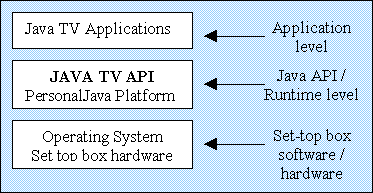|
|
 Get the latest Java books |
|
|
h t t p : / /w w w . j a v a c o f f e e b r e a k . c
o m /
|
||
|
Menu Articles Using Java Applets Looking for Java resources? Check out the Java Coffee Break directory! |
Java coming to a TV near you!By David Reilly.
Okay. When I first read about the Java TV API last year, I thought the idea of Java running on set-top boxes was quite amusing. After all, we've all had the experience of slow loading applets running inside web-browsers, that amount to little more than eye-candy for the easily amused. Certainly, there are some serious Java applets out there, but they're few and far between, and with cross-browser compatibility issues, limited in their audience reach. Then the enormity of it hit me - while the number of computers in households is still small, and the number of Internet users even more so, the number of people with television sets is MASSIVE. This one concept has the potential to introduce the word "Java" to hundreds of millions of people world-wide. Digital TV may be slow to get a foothold, but it's almost a certainty. Now imagine all those people running Java applications (or applets) right from their television. High bandwidth HDTV or cable connections could be integrated with interactive Java content, ranging from simple games, stock tickers, and online shopping. The scope of the Java TV API is very big indeed. The Java TV API is designed to allow Java applications access to the functionality of the television host on which it runs. Through the Java TV API, which will provide access to television programming content (de-multiplexed on-the-fly), content selection (program guides), and control over the television screen appearance. Applications can run on a Java Virtual Machine (JVM) designed for set-top boxes, televisions, and real-time devices. The underlying hardware details are abstracted away, leaving developers free to concentrate on developing interactive content, not porting it from one system to another.
Here's where Java technology comes into its own. Not only is it portable, not only is there an existing code base to work with and familiarity amongst developers, but it will be easy to move applications from one system to another. That means consumers (and cable companies) won't be left with antiquated systems that can only run a small range of software. Integrated with the Java TV API will be other related technologies. For example, Java already has support for decoding and processing multimedia content, through the Java Media Framework. New decoders for television content can be added, as well as existing mechanisms such as MPEG. Imagine a high speed cable network that allows audio playback of MP3 music! As new content streaming formats are developed, applets can gain access to decoders as they are added to the JMF. This means that set-top software doesn't need to be manually updated - new formats can be downloaded on-the-fly. The Java TV API has the potential to revolutionize the Java landscape. Sure Java made inroads into browsers, and is having increasing success in the server-side market, but imagine the potential of set-top boxes all around the world running Java. That's a big market for Sun, for cable and television companies, and for software developers. For more information on the Java TV API, you can follow its progress at Sun, http://java.sun.com/products/javatv/ |
||||
|
|||||



